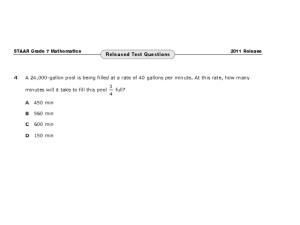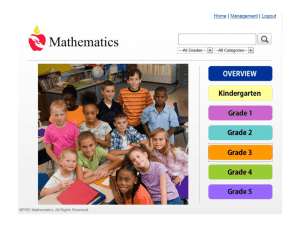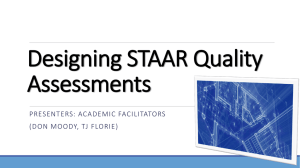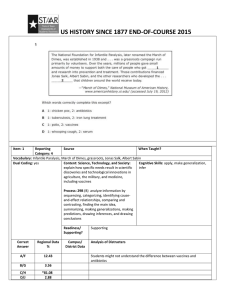From Blueprint to Construction: High School Math Assessments
advertisement
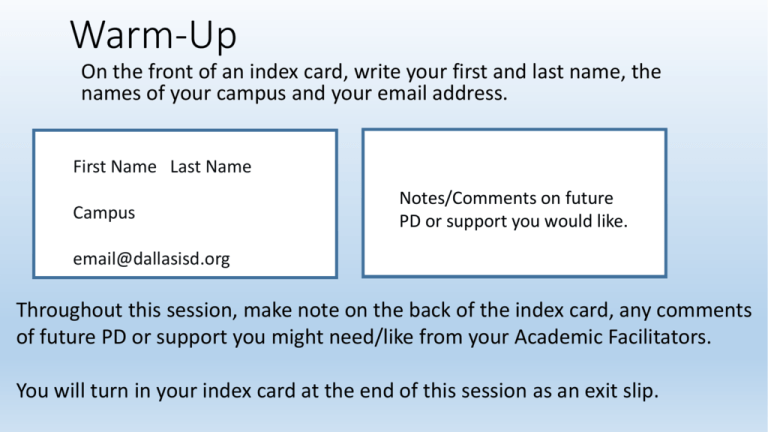
Warm-Up On the front of an index card, write your first and last name, the names of your campus and your email address. First Name Last Name Campus Notes/Comments on future PD or support you would like. email@dallasisd.org Throughout this session, make note on the back of the index card, any comments of future PD or support you might need/like from your Academic Facilitators. You will turn in your index card at the end of this session as an exit slip. From Blueprint to Construction: High School Math Assessments Instructional Coach Conference August 8 & 9, 2013 Presented by your High School Math Academic Facilitators: Betsy Urschel, Division 4 burschel@dallasisd.org Ercleo Esquejo, Division 2 eesquejo@dallasisd.org Rosa Darkwa, Division 3 rdarkwa@dallasisd.org Outcomes: o Campus Instructional Coaches will come away with a common understanding of how to examine and analyze longitudinal data. o Campus Instructional Coaches will understand how to effectively utilize the Assessment Blueprint Template. o Campus Instructional Coaches will articulate the importance of using data and unpacking standards to determine the content and cognitive levels in the assessment development process. Dallas ISD Core Beliefs 1. Our main purpose is to improve student academic achievement. 2. Effective Instruction makes the most difference in student academic performance. 3. There is no excuse for poor quality instruction. 4. With our help at risk students will achieve at the same rate as non-at risk students. 5. Staff members must have a commitment to children and a commitment to the pursuit of excellence. not merely to evaluate them, but to improve the entire process of teaching and learning.” - Douglas B. Reeves, Making Standards Work Which core belief(s) does the quote reflect? Be prepared to explain why and share. Planning for Interim Assessments Step Process for Creating Quality Assessments 1. DATA: A Look at the Data 2. CONTENT: Identifying Know and Do 3. PROCESSES: Identifying Processes and Skills 4. REVIEW EXAMPLES: What are we looking for in an item? 5. ITEM AND TEST LEVELING: Are items written at the appropriate cognitive level based on the TEKS? 6. ITEM DESIGN: Do test items follow best practices in item design? Step Process for Creating Quality Assessments 1. DATA: A Look at the Data 2. CONTENT: Identifying Know and Do 3. PROCESSES: Identifying Processes and Skills 4. REVIEW EXAMPLES: What are we looking for in an item? 5. ITEM AND TEST LEVELING: Are items written at the appropriate cognitive level based on the TEKS? 6. ITEM DESIGN: Do test items follow best practices in item design? 1. DATA Identifying High Priorities for Assessment • Look at your longitudinal data for Algebra 1. TEKS SE Unit 2 A1.A Unit 4 Unit 5 Unit 8 67.19% 72.25% A1.B 68.39% 71.52% A1.C 42.16% 67.66% A1.D 83.09% 32.03% 87.70% A1.E 62.86% 68.46% A7.A 74.04% A7.B 2011 TAKS% 2012 STAAR% Average 89.92% 89.92% 79.82% 76.91% 76.91% 73.43% 49.04% 49.04% 51.98% 89.77% 88.36% 81.96% 77.15% 56.10% 46.90% 60.77% 40.12% 55.87% 76.35% 82.82% 76.39% 68.11% 72.20% 74.99% 72.00% 78.03% 76.48% 81.48% 73.36% 77.37% 76.45% A7.C 84.83% 88.47% 75.15% 75.45% 60.90% 68.09% 75.48% A8.A 72.14% 69.34% 92.14% A8.B 58.05% 79.28% 50.44% A8.C 74.75% 56.95% 64.88% 77.87% 52.30% 51.38% 58.29% 64.88% 65.37% • What areas have been problematic for TAKS/STAAR in past? Circle these SEs Identifying High Priorities for Assessment • Highlight Readiness Standards in Pink • Highlight Supporting Standards in Green 1. Functional Relationships Reporting Category STAAR 8 STAAR Modified 6 Readiness Standards Supporting Standards A1.A Describe independent and dependent quantities in functional relationships. A1.D Represent relationships among quantities A1.B Gather and record data and use data sets to using concrete models, Tables, graphs, diagrams, determine functional relationships among verbal descriptions, equations, and inequalities quantities A1. E Interpret and make decisions, predictions, A1.C Describe functional relationships for given and critical judgments from functional relationships, problem situations and write equations or inequalities to answer questions arising from the situations, TEKS SE Unit 2 A1.A Unit 4 Unit 5 Unit 8 67.19% 72.25% A1.B 68.39% 71.52% A1.C 42.16% 67.66% A1.D 83.09% 32.03% 87.70% A1.E 62.86% 68.46% A7.A 74.04% A7.B 2011 TAKS% 2012 STAAR% Average 89.92% 89.92% 79.82% 76.91% 76.91% 73.43% 49.04% 49.04% 51.98% 89.77% 88.36% 81.96% 77.15% 56.10% 46.90% 60.77% 40.12% 55.87% 76.35% 82.82% 76.39% 68.11% 72.20% 74.99% 72.00% 78.03% 76.48% 81.48% 73.36% 77.37% 76.45% A7.C 84.83% 88.47% 75.15% 75.45% 60.90% 68.09% 75.48% A8.A 72.14% 69.34% 92.14% A8.B 58.05% 79.28% 50.44% A8.C 74.75% 56.95% 64.88% 77.87% 52.30% 51.38% 58.29% 64.88% 65.37% Your Turn: Creating an Assessment Blueprint • List the TEKS that will be assessed on the blueprint • Identify whether they are Readiness or Supporting standards • Circle any SE that in High Priority ASSESSMENT BLUEPRINT TEMPLATE . . SE Readiness/ Supporting R/S R/S R/S SE Content Specificity Number of Items Needed 2. CONTENT TEKS and Assessment: Things to Remember • The wording of the standard tells us WHAT CONTENT will be assessed on STAAR • The wording tells us at WHAT LEVEL the standard will be assessed on STAAR • Content • The content items for which students must demonstrate understanding at the appropriate cognitive level in order to adequately meet the standard. • Cognitive • The level at which students are expected to perform in order to adequately meet the standard. • Determined by the verbs used in both the Knowledge and Skills statements and the Student Expectations Content & Cognitive Exectations What Should Students KNOW? • Background knowledge they will need to have in order to ensure understanding and application of the standards? • What vocabulary must the student know and be able to use to have success? • What should they understand at end of lesson? Algebra 1 Strand Student Expectations 5. Linear Functions. The student understands that linear functions can be represented in different ways and translates among their various representations. The student is expected to: (A) Determine whether or not given situations can be represented by linear functions. (B) Determine the domain and range for linear functions in given situations; and (C) Use, translate, and make connections among algebraic, tabular, graphical, or verbal descriptions of linear functions. Your Turn: Refer to your TEKS • Look at the at the TEKS listed on your handout • Identify what the students need to KNOW and DO based on the TEKS • Decide how many items would be needed to test this material ASSESSMENT BLUEPRINT TEMPLATE . . SE Readiness/ Supporting R/S R/S R/S SE Content Specificity Number of Items Needed Planning for Interim Assessments: 1. DATA: Identify and assess high priority TEKS 2. CONTENT: Identify what students need to Know and Do • What will be assessed and how? • Identify the content and concepts that will be assessed. Final Reflection: How will you implement the information presented in this session as a Campus Instructional Coach (CIC) to increase student achievement?


